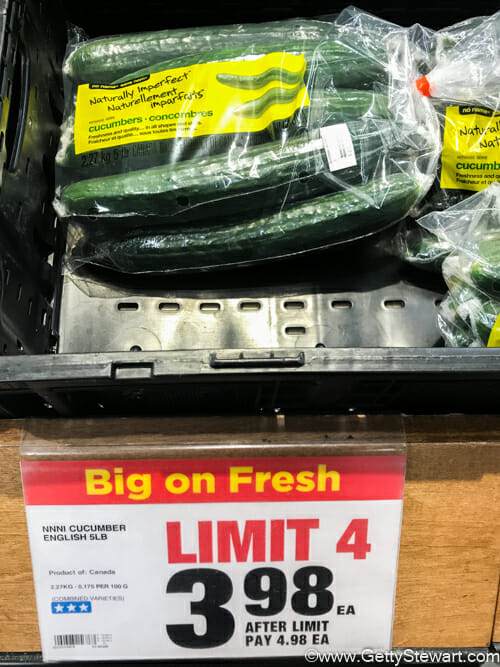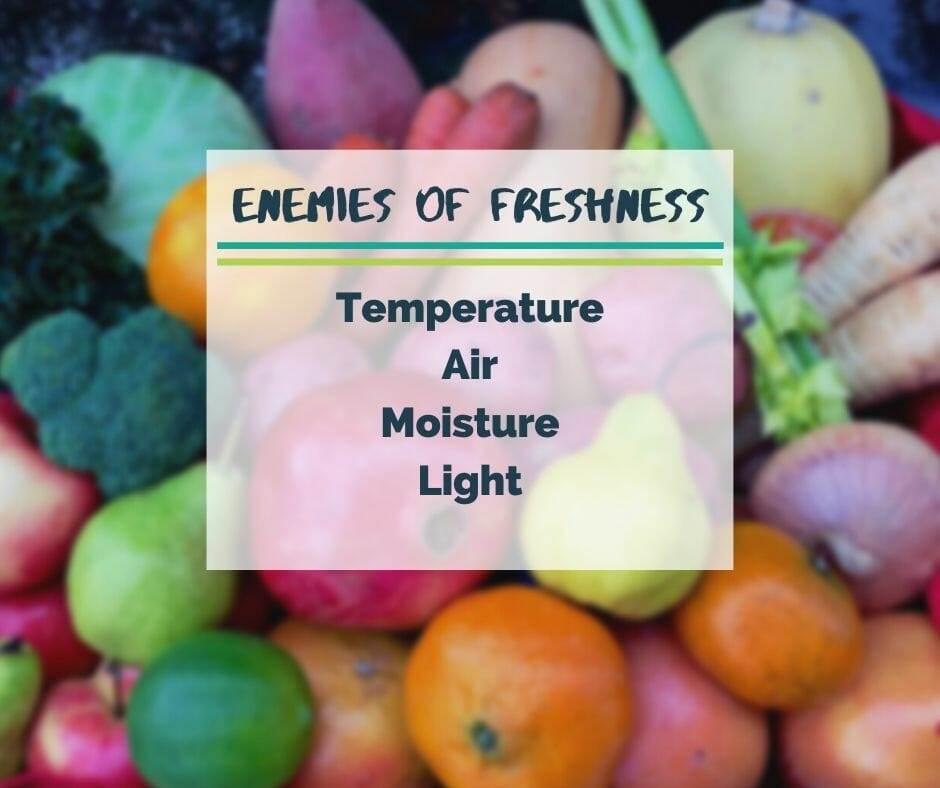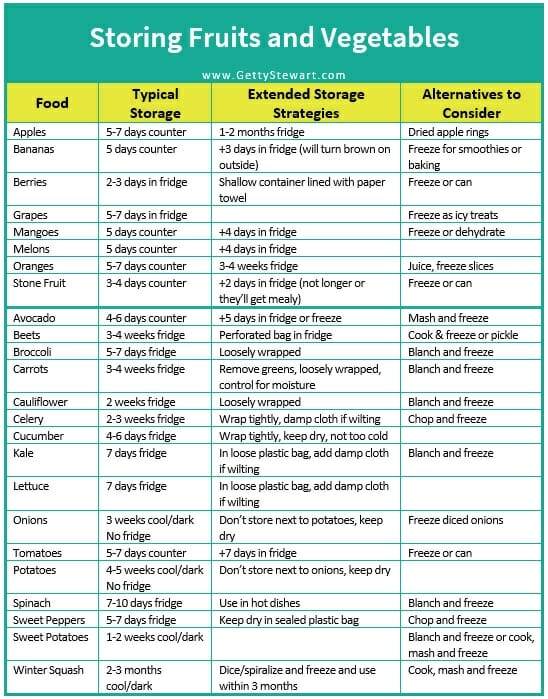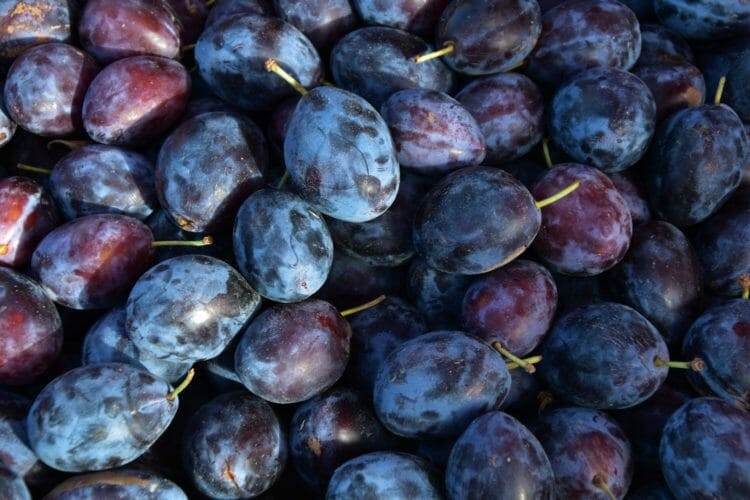How to Store Fruits and Vegetables to Keep Them Fresh and Tasty
Wondering how to store fruits and vegetables to keep them fresh and tasty for as long as possible? Here are some tips for effectively storing fresh produce to make the most of your purchases and help reduce food waste.
Did you know that us North American consumers waste fresh fruits and veggies more than any other food? It’s true, in Canada, the National Zero Waste Council (2018) found that vegetables are the most-wasted food. By weight, our household food waste is 30% vegetables and 15% fruit. How sad is that?! All those beautiful fruits and veggies tossed because we didn’t plan better or store them effectively.
Steps to Keep Produce Fresh
1. Shop with a plan/list.
Undoubtedly the most beautiful space in the grocery store is the produce section. In fact it is designed to be so enticing that you buy, buy, buy! It’s hard to resist the lure of colorful, fresh produce. And most of us fall into the trap of buying WAY more produce than we can consume before it goes bad.
DON’T be tempted. Make a plan and stick to it! Only buy the fruits and veggies that are on your list.

And don’t be tempted by sales that offer big discounts if you buy in large multiples. Eight cucumbers for $3.98 looks like an amazing price. But it’s not if 6 or 7 of them end up in the garbage or compost bin.
2. Eat the most perishable produce first.
Plan your meals so that your most perishable fruits and veggies are enjoyed first. When stored as recommended you can expect fruits and veggies to last as shown in the charts below. Eat the produce at the top of the lists first.

3. Control for Enemies of Freshness to Keep Produce Fresh
We can keep produce fresh the longest when we control for the enemies of freshness.

Temperature – Store fruits and veggies based on their preferred temperature.

Air – Most fruits and veggies prefer to have some air circulation, but too much air may cause them to dry out.
Off gassing by the produce itself may also cause issues. Many fruits and a few veggies give off ethylene gas, a natural plant hormone that encourages produce to ripen. Faster ripening leads to faster spoilage. So, as much as possible, it’s best to keep the ethylene producers separate from other fruits and veggies – unless you want that other produce to ripen faster.
Ethylene producers include:
Apples
Apricots
Avocados (ripe)
Bananas (ripe)
Cantaloupe
Figs
Grapes
Kiwi
Mangoes
Nectarines
Peaches
Pears
Plums
Tomatoes
If possible, store these fruits and veggies away from other produce to slow ripening and spoilage. I know it’s hard to store all your fruits and veggies separately, so just think about what produce is the most challenging for you and see if you can store it differently.
Moisture – By controlling humidity we can keep produce fresh longer. You can tell if you need to add or remove moisture by what’s happening to the produce in your fridge. Is your produce rotting or wilting?
Produce is Rotting/Slimy/Gooey = Too Damp – Take produce out of current bag. Remove any yucky bits. Wash, dry well and wrap in dry paper towel and loosely place in a plastic bag with holes in it or that is left open.
Produce is Dry/Wilting/Shriveling = Too Dry – Wrap produce in a slightly damp paper towel (NOT soaking wet) and place in a loosely closed plastic bag.
Light – Strong light, especially direct sunlight will cause produce to spoil faster.
4. Use Your Crisper Drawers Effectively to Keep Produce Fresh
Those little sliders on your crisper drawers actually can make a difference. They can help you manage air circulation, humidity and those ethylene gas producers. There’s nothing magical about them, that slider that goes from high to low really just opens or closes a little slot that lets air in or out. When the slot is open more air is allowed to enter into the crisper drawer, this means that moisture and ethylene can escape from the drawer. When the slot is closed all the air and moisture in that crisper drawer is trapped inside the drawer. Knowing the difference can help you select which fruits and veggies to place in which drawer. Or you can just look at the following chart!

5. Don’t Wash Until Ready to Use, except if…
As a general rule of thumb, don’t wash your fruits and vegetables until you’re ready to use them. Most fruits and veggies have a natural coating that helps seal in moisture and keep out pathogens. When we wash produce, we wash away that natural coating.

Here’s the exception to the rule. If your produce is soaking wet from being misted at the grocery store, your best bet is to wash it and dry it before storing. This is often the case with lettuce or herbs like parsley, cilantro or green onions. Here’s a brief video on how I wash, dry and store cilantro to keep it for weeks.
Storing vegetables the right way will keep them fresh and safe to eat. Some vegetables and fruit need to be stored in the refrigerator, others need to ripen before being placed in the refrigerator, and others are best stored at room temperature or in a cool dry place. Find out more about how your favourite vegetables should be stored.
If All Else Fails – Preserve It!
If, even all these efforts, your produce is still on the verge of spoiling, consider preserving them before they turn. You could certainly dehydrate, pickle, jam or can them, but the fastest and easiest way to preserve them is by freezing them.
Read Blanching and Freezing Fruits and Vegetables to find everything you need to safely and effectively freeze fruits and vegetables.
Most fruits just need to be cleaned, peeled and cut before sealing tightly in a freezer container.
Most vegetables need to be blanched (briefly boiled in water) before freezing. Blanching is necessary to keep their color, flavor and texture at their best. For blanching times and instructions read Blanching and Freezing Vegetables.
Frozen fruits and veggies will change in texture. Do not expect to eat them just as you would raw. The higher the water content, the more changes to the structure of the fruits and vegetables. Some, like lettuce or cucumbers do not freeze well at all.
Special Gadgets and Washes to Keep Produce Fresh
I know the marketplace has some pretty nifty gadgets, washes, containers, sprays and products to help keep produce fresh longer. I haven’t tried any of them. I’m happy with the results that I get by implementing the strategies recommended above. I’m not much of a gadget person and I don’t like spending money when I don’t need to.
Participants in workshops offer mixed reviews. Some people rave about various products, others say they haven’t found a difference and some say they got tired of using them. There isn’t a single product that has repeatedly gotten such rave reviews that I felt compelled to try it.
But hey, if you love gadgets – I’m sure there’s some sort of gizmo out there for you to try.
Sheesh, that’s a lot of info! Luckily, most of it becomes second nature when you take time to observe and think about what’s happening to your produce and what changes you can make. And it starts by simply not buying too much at any one time.
What fruit or vegetable is the most challenging for you? What do you do that works well for you? I’d love to hear your comments, either below or on instagram @getgettys or Facebook @GettyStewart.HomeEconomist.
Getty Stewart is a Professional Home Economist, speaker, frequent media guest and writer dedicated to putting good food on tables and agendas. She is the author of several recipe books on enjoying and preserving fruit, Founder of Fruit Share, a mom and veggie gardener.
Cook with the seasons, effortlessly! I’m Getty, a food educator and Professional Home Economist, helping you select, store, and serve seasonal ingredients in delicious, simple, everyday meals. Sign up for seasonal tips and recipes delivered straight to your inbox, and dive deeper with my books, guides, or YouTube content.



Thanks Getty, for all you do to help all of us become more informed on getting the most value for our food dollar. The seeds of wisdom that you sow in us will continue to yield in the months and years ahead. I’ve long held thoughts that tougher economic times were inevitable; though who would have thought that an international health issue would be the vehicle upon which they would arrive?
In preparation for these times, I enrolled in a week long course in permaculture a few years ago. I have over the years gathered a variety of resources related to gardening & homesteading. I live on a small acreage in Lac Lu (N.W. of Kenora Ontario). I have limited gardening experience, and was wondering if you might recommend a resource, that’s kind of a progressive framework for establishing and maintaining a vegetable garden using the best tried & true practices? I guess I’d like to acquire a fairly comprehensive (hand holding resource) so I can successfully delve into a field that is relatively new to me. Earlier this week I was entertaining the Green Thumbs Food Gardening Course offered by Saskia Esslinger. It’s a 4 season course for about $850.00 CDN. Though of considerable value, as a frugal pensioner; I thought I’d ask,if you might recommend an alternative resource or resources.
Once again, Thank You for your valuable e-mails. Having been brought up by parents who lived on farms thru the 30’s I truly value what you do.
Sincerely, Jake
Hi Jake,
Thank you for your kind comments. I’m fortunate that my rural farm roots, my mom’s teachings and my formal University education have all culminated in a job I love – sharing practical home cooking/kitchen skills.
Unfortunately, I don’t know of one all encompassing resource that I can point you to re establishing and maintaining a garden year round. I use a hodge podge of resources – library books, Facebook groups, fellow community gardeners, workshops at local gardening shows and so on. I suspect a one-stop resource to see you through the gardening season will cost some money. I don’t know anything about the course you’re considering or what’s included, but I’d certainly want to see reviews and maybe talk to people who’ve taken it before spending that amount of money. It may well be worth it, I’d just want to check to see it delivers what you’re really wanting.
If I come across anything in the next little while, I’ll let you know.
You live in a gorgeous area! Good luck with your gardening efforts. Wish I could come and visit!
Getty
CarolD Sent in the following: I keep my berries for more than a week by sloshing them in a mild vinegar water solution and then putting a dry cloth in with them to absorb extra water. Grapes last a lot longer when I do this too. I check to make sure my napkins or paper towel get changed as they get wet. Damp is okay but visible water droplets aren’t. Carol